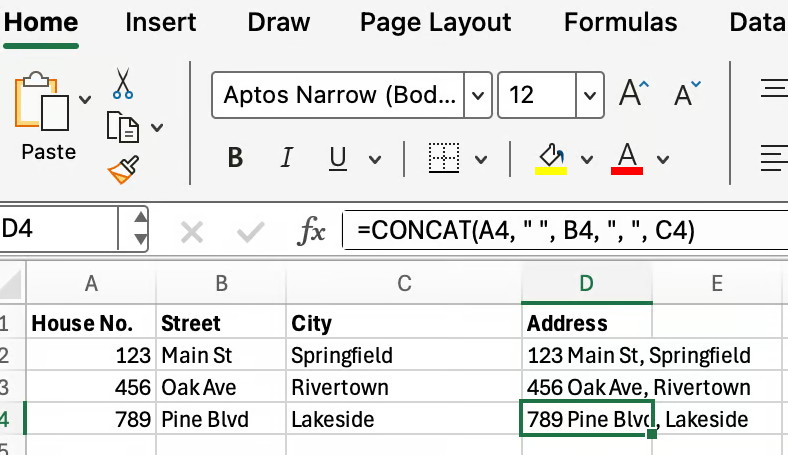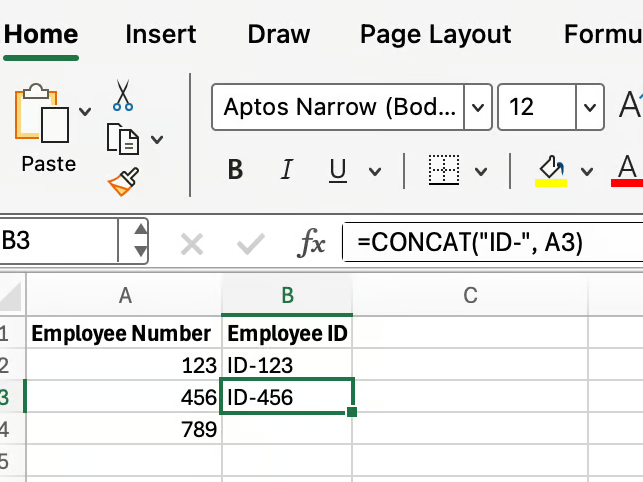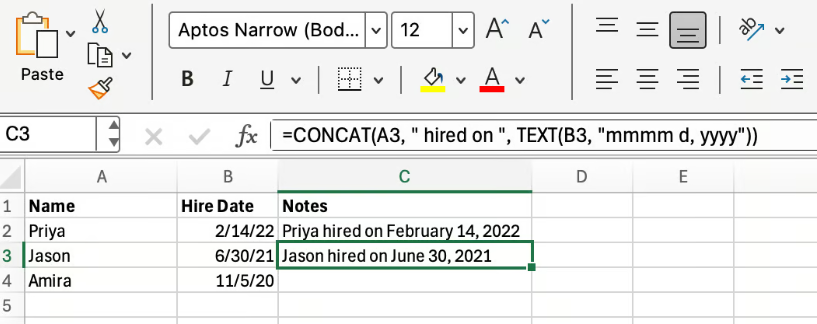Key Takeaways
- Manual text merging in Excel is time-consuming and error-prone, especially for non-technical users who struggle with complex formula syntax
- Excelmatic's AI-powered approach eliminates the formula learning curve, allowing you to combine text using simple language instructions instead of memorizing functions
- The platform handles complex data transformations automatically, including separator management, empty cell handling, and formatting - tasks that typically require advanced Excel knowledge
- For business users seeking productivity gains, Excelmatic provides the fastest path from raw data to formatted results without technical expertise
Combining text from different cells—like merging first and last names, or piecing together an address—is a fundamental task in Excel. It helps you tidy up data, prepare mailing lists, and create custom labels without tedious manual entry.
While Excel offers powerful functions like CONCAT() and TEXTJOIN() for this job, mastering their syntax and limitations can be time-consuming. But what if you could skip the formulas entirely?
In this guide, we'll walk you through the traditional formula-based methods and introduce a revolutionary AI-powered approach. You'll see how each method works and learn which one is best for your needs, from simple merges to complex data transformations.
The Effortless AI Method: Combine Text with Excelmatic
Before diving into manual formulas, let's look at the fastest and most intuitive way to get the job done. Excelmatic is an AI Excel Agent that understands plain language instructions, allowing you to perform complex tasks without writing a single formula.

With Excelmatic, the process is simple:
- Upload your Excel file.
- State your request in plain English.
- Let the AI handle the rest.
For instance, if you have first names in column A and last names in column B, you don't need to remember CONCAT() or worry about adding spaces. You would simply tell Excelmatic:
Combine the first name from column A and the last name from column B into a new column named 'Full Name', separated by a space.
Excelmatic instantly processes your request and delivers a perfectly formatted column. The same logic applies to more complex tasks, like merging an address:
Merge the street from column C, city from column D, and zip code from column E into a new 'Full Address' column. Separate the street and city with a comma and a space.
The advantages of this AI-driven approach are clear:
- No Syntax to Learn: You communicate naturally.
- No Manual Errors: Forget missing commas or incorrect cell references.
- Incredible Speed: It handles thousands of rows in seconds.
- Flexibility: It can handle data cleaning, analysis, charting, and more, all from simple instructions.
For anyone looking to boost productivity and skip the formula learning curve, an AI tool like Excelmatic is the ultimate solution.
The Manual Formula Method: Using CONCAT()
For those who prefer to write formulas or need to work within an existing spreadsheet, Excel's built-in functions are still very powerful. The modern standard for this is CONCAT().
CONCAT() stands for "concatenate," which means to link things together in a chain. It's a modern replacement for the older CONCATENATE() function because it's shorter to type and can handle cell ranges.
The syntax is straightforward:
=CONCAT(text1, [text2], ...)
Each argument can be a cell reference, a range, or a text value you want to combine.
CONCAT() in Everyday Spreadsheets
Let's see how CONCAT() handles common scenarios.
Combining first and last names into one cell
This is the most common use case. Suppose you have first names in column A and last names in column B. To merge them with a space in between, you’d use:
=CONCAT(A2, " ", B2)

This formula joins the content of cell A2, a space character (" "), and the content of B2. Notice you have to manually insert the separator. With Excelmatic, you'd simply state this in your request without worrying about the quotes or syntax.
Merging address elements
Addresses almost always span several columns. With CONCAT(), you can combine them for mailing labels or cleaner records.
=CONCAT(A2, " ", B2, ", ", C2)

Joining a range of cells
One key advantage of CONCAT() over the old CONCATENATE() is its ability to join entire ranges. For example, to combine values in cells A2 through E2, you can use:
=CONCAT(A2:E2)

As you can see, Excel merges the contents in order, but with no separators. The result looks jumbled. This highlights a strength of CONCAT() (handling ranges) but also its biggest weakness compared to more advanced solutions like Excelmatic that automatically handle separators.
Limitations with CONCAT()
It’s important to understand CONCAT()'s quirks to avoid frustration.
- No Automatic Separators:
CONCAT()does not add spaces or commas automatically. You must insert them manually as text (" "). - Ignores Empty Cells: It silently skips empty cells, which can cause values to run together unexpectedly.
- No Delimiters Across Ranges: You cannot use
CONCAT()to automatically insert a comma between each item in a range likeA2:E2. This is where the function falls short for list-building. - Text-Only Output:
CONCAT()always produces a text string, even if you combine numbers.
These limitations often mean business users need either advanced formula knowledge or a smarter tool like Excelmatic that bypasses these complications entirely.
A Better Formula: CONCAT() vs. TEXTJOIN()
When CONCAT() isn't enough, TEXTJOIN() is your go-to formula. It's designed specifically to solve CONCAT()'s biggest problems.
Working with TEXTJOIN() for custom separators
TEXTJOIN() lets you merge values while automatically inserting a consistent delimiter (like a comma or space) between each item. It can also choose to ignore empty cells.
The syntax is:
=TEXTJOIN(delimiter, ignore_empty, text1, [text2], ...)
For example, to join all values in A2:E2, separated by commas, and skipping blanks, you would use:
=TEXTJOIN(", ", TRUE, A2:E2)

As you can see, TEXTJOIN() is far more elegant for lists and addresses, especially over long ranges where a CONCAT() formula would become unwieldy:
=CONCAT(A1, ", ", B1, ", ", C1, ", ", D1, ", ", E1)
Understanding CONCATENATE() (and why it’s outdated)
CONCATENATE() was Excel’s original text-joining function. Its main drawback is that it doesn’t accept ranges; you must list every single cell. It is only kept for backward compatibility. You’re better off with CONCAT() or TEXTJOIN() in any modern workflow.
Quick Comparison: AI vs. Formulas
| Feature | Excelmatic (AI Agent) | TEXTJOIN() |
CONCAT() |
|---|---|---|---|
| Ease of Use | Easiest (Plain English) | Intermediate (Requires syntax) | Easy (Simple syntax) |
| Adding Separators | Automatic (Just ask) | Automatic (Built-in delimiter) | Manual (Add " " or ",") |
| Handling Ranges | Flawless | Excellent | Basic (No separators) |
| Skipping Blanks | Handles intelligently | Yes (Built-in option) | Ignores, can cause issues |
| Speed | Fastest for any task | Fast for experts | Fast for simple tasks |
| Learning Curve | None | Moderate | Low |
Tips and Tricks for Formulas
If you're sticking with formulas, these tips will help you use CONCAT() more efficiently.
Incorporating constants and formatting
You can combine cell references with fixed text. For example, to add a prefix "ID-" to an employee number in A2:
=CONCAT("ID-", A2)

Handling numbers and dates
Since CONCAT() treats everything as text, dates and numbers can lose their formatting. Use the TEXT() function inside your formula to control this.
=CONCAT(A2, " hired on ", TEXT(B2, "mmmm d, yyyy"))

This ensures your output is perfectly styled for reports or mail merges.
Conclusion
Whether you're managing lists, cleaning data, or preparing reports, knowing how to combine text is a crucial Excel skill.
- The AI-powered approach with Excelmatic is the clear winner for speed, ease, and power. It lets you focus on your goal, not on formula syntax.
TEXTJOIN()is the best manual formula for the job, offering the flexibility to handle delimiters and empty cells properly.CONCAT()is a reliable choice for very simple merges where you don't need complex separators.
While mastering Excel formulas is a valuable skill, modern AI tools like Excelmatic are transforming how business teams work with data. By offloading tedious tasks like data merging to an AI agent, you can save time, reduce errors, and focus on more strategic analysis.
Ready to transform how you work with Excel? Try Excelmatic today and experience the power of AI-driven data processing for yourself.
Why does CONCAT() not insert spaces or commas between items automatically?
The CONCAT() function is designed for simple joining and does not add any separators by default. You must manually add separators as text strings within the formula, like =CONCAT(A2, " ", B2). This is why TEXTJOIN() or AI-driven tools are often preferred, as they handle separators automatically.
What happens when CONCAT() encounters blank cells?
When CONCAT() merges a range, it silently ignores any empty cells. This can sometimes lead to odd-looking results where values run together. For more control, use TEXTJOIN(), which has an option to handle blank cells, or Excelmatic which can interpret your needs more intelligently and handle edge cases automatically.
Can I use CONCAT() to combine a range with commas in between values?
No, CONCAT() cannot insert separators between items in a range like A2:E2. This is a key limitation. For this task, you must use TEXTJOIN(), for example: =TEXTJOIN(", ", TRUE, A2:E2). Alternatively, you can simply ask Excelmatic to do it for you in plain language.
Why does CONCAT() return text even when I combine numbers?
The CONCAT() function's purpose is to create a string of text, so its output is always a text string. To preserve number or date formatting, you must nest the TEXT() function inside your formula, like =CONCAT("Hired on ", TEXT(B2, "mm/dd/yyyy")).
When should I use Excelmatic, TEXTJOIN(), or CONCAT()?
- Use Excelmatic when you want the fastest, easiest result without writing formulas, especially for complex or large-scale tasks.
- Use
**TEXTJOIN()**when you need to write a formula that inserts a consistent delimiter (like commas or spaces) and handles empty cells. - Use
**CONCAT()**for simple, straightforward merging where you don't need automatic separators or range-based delimiters.






